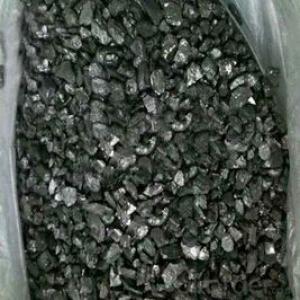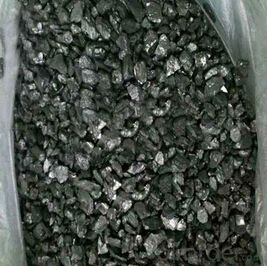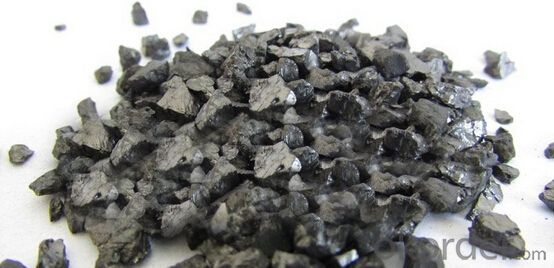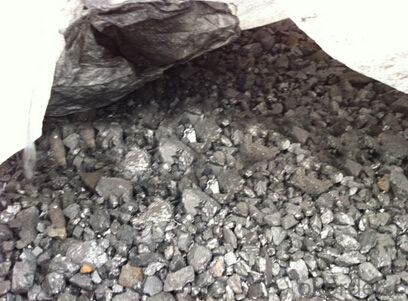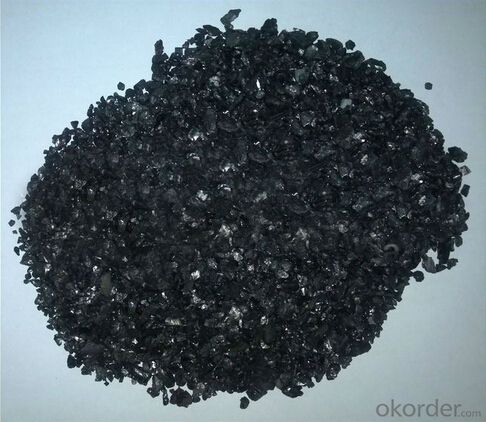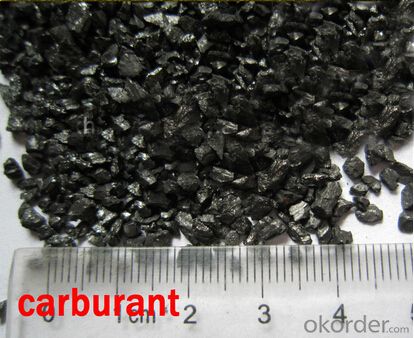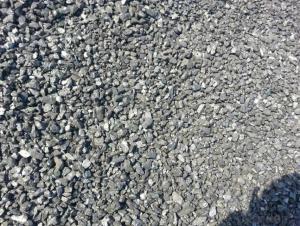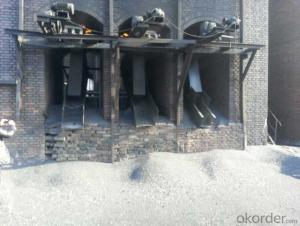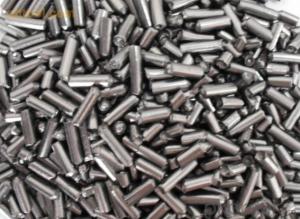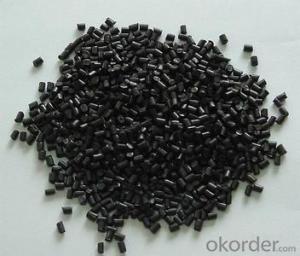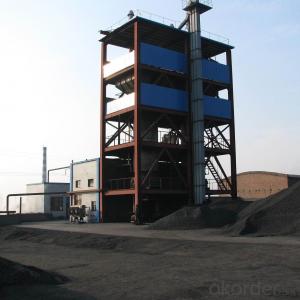Recarburizer updated material for iron melting foundry
- Loading Port:
- Dalian
- Payment Terms:
- TT OR LC
- Min Order Qty:
- 10 m.t
- Supply Capability:
- 500000 m.t/month
OKorder Service Pledge
OKorder Financial Service
You Might Also Like
Specifications:
The chemical composition is pure: high carbon, low sulfur, tiny nitrogen, slightly less harmful impurity.
The carburant has excellent features of high carbon, low sulfur, low nitrogen and little impurity. This product is used in casting, can significantly increase the amount of scrap steel, reduce the pig iron dosage or do not use pig iron. At present most recarburizer are suitable for electric furnace smelting, also have a few special recarburizer with fast absorption rate is used in cupola furnace.
Data Sheet:
Product Num. | Fix carbon (mix) | Sulphur (max) | Ash (max) | Volatile Matter(max) | Moisture (max) | Grain size
| Nitrogen (max) |
GH-CA-01 | 99.00% | 0.03% | 0.50% | 0.50% | 0.50% | 0.15-5mm | 300ppm |
GH-CA-02 | 98.50% | 0.06% | 0.80% | 0.70% | 0.50% | 0.15-5mm | 300ppm |
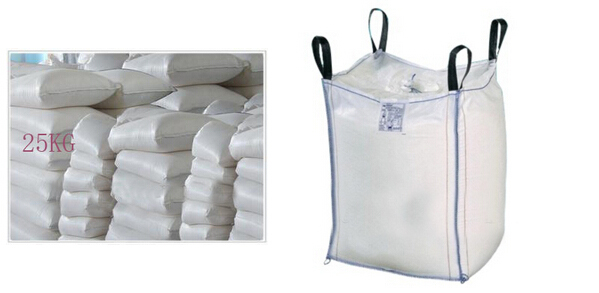
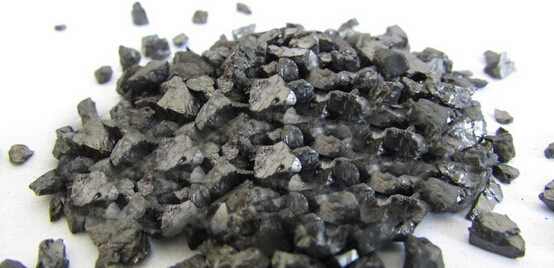
- Q: How is carbon used in the production of ceramics?
- Carbon is used in the production of ceramics as a key component in the creation of carbon-based materials, such as carbon fibers or carbon nanotubes, which can be incorporated into ceramic matrices to enhance their mechanical properties, electrical conductivity, and thermal stability. Additionally, carbon can also be utilized as a reducing agent in certain ceramic processes, such as the production of silicon carbide, where it reacts with oxygen to remove impurities and stabilize the ceramic structure.
- Q: What is the density of carbon?
- The density of carbon depends on its form. The most common form of carbon is graphite, which has a density of 2.267 grams per cubic centimeter (g/cm³). However, another form of carbon called diamond has a much higher density of 3.515 g/cm³. So, it is important to specify which form of carbon we are referring to when discussing its density.
- Q: What is the role of carbon in the formation of fossil fuels?
- The role of carbon in the formation of fossil fuels is crucial. Fossil fuels, such as coal, oil, and natural gas, are formed from the remains of ancient plants and organisms that lived millions of years ago. These organisms were primarily made up of carbon-based compounds. Over time, the organic matter accumulated and was buried under layers of sediment, subjected to intense heat and pressure. This process, known as carbonization, caused the carbon within the organic matter to undergo chemical changes, transforming it into fossil fuels. Therefore, carbon is the key element involved in the formation of fossil fuels.
- Q: How is carbon used in the production of pharmaceuticals?
- Carbon is used in the production of pharmaceuticals through various processes such as carbonization, activation, and purification. It serves as a crucial component in the synthesis of drugs and plays a significant role in drug formulation, purification, and separation processes. Additionally, carbon-based materials are utilized as drug carriers and adsorbents to enhance drug delivery and optimize the efficiency of pharmaceutical manufacturing.
- Q: What are the long-term effects of increased carbon emissions on ecosystems?
- Increased carbon emissions have significant long-term effects on ecosystems. One of the most notable impacts is climate change, as carbon dioxide is a greenhouse gas that traps heat in the atmosphere. This leads to rising temperatures, altered weather patterns, and increased frequency and intensity of extreme weather events such as hurricanes, droughts, and wildfires. These changes in climate have numerous negative consequences for ecosystems. For instance, rising temperatures directly affect the physiology and behavior of plants and animals. Many species have specific temperature requirements for reproduction, feeding, and survival, and even slight changes can disrupt their life cycles and lead to population declines or extinctions. Furthermore, increased carbon emissions contribute to ocean acidification, a process where the excess carbon dioxide in the atmosphere dissolves in seawater, forming carbonic acid. This acidification has devastating effects on marine ecosystems, particularly coral reefs and shell-forming organisms like oysters and clams. It weakens their calcium carbonate structures and inhibits their growth and reproduction, ultimately leading to their decline. In addition, carbon emissions influence the distribution and composition of plant communities. As carbon dioxide is a vital component for photosynthesis, elevated levels can enhance plant growth and productivity. However, this can also lead to changes in plant composition and the competitive balance between species, favoring certain fast-growing species over others. This can disrupt the delicate relationships between plants and their pollinators, herbivores, and other organisms, affecting the entire food web. Moreover, increased carbon emissions contribute to the loss of biodiversity. Many species are highly specialized and adapted to specific environmental conditions. As habitats change due to climate change, certain species may struggle to adapt or find suitable alternatives, leading to declines or local extinctions. This loss of biodiversity can have cascading effects throughout ecosystems, disrupting ecological processes and reducing the resilience and stability of entire ecosystems. Overall, increased carbon emissions have far-reaching and detrimental long-term effects on ecosystems. They cause climate change, ocean acidification, alter plant communities, and drive biodiversity loss. It is crucial to reduce carbon emissions and mitigate climate change to protect and preserve the health and functioning of ecosystems for future generations.
- Q: What should be done to deal with leakage of carbon monoxide from the plant?
- The hazardous and dangerous characteristics of carbon monoxide, carbon monoxide, is the Chinese name of CO. It is the product of incomplete combustion of materials. It is slightly soluble in water and soluble in various organic solvents such as ethanol and benzene. Mainly used in industrial chemical synthesis, such as synthetic methanol, phosgene, etc., or refined metal reducer. Occupation exposure to carbon monoxide in manufacturing steel and iron, coke, ammonia, methanol, graphite electrode, printing and dyeing factory, singeing, internal combustion engine powered coal mining blasting; non occupation contact is more extensive, such as household water heater was boiling water, winter coal, gas heating and so on, will produce carbon monoxide. Carbon monoxide is a flammable toxic gas known, but because of its physical and chemical properties of colorless smelly, so it is not easy to be aware of the harm, so it is not only the occupation killer, or the people's daily living potential. Carbon monoxide mixed with air can form an explosive mixture. When exposed to fire, high heat can cause combustion and explosion. Bottled carbon monoxide in case of high fever, increased pressure within the container, cracking and explosion. Because carbon monoxide has flammable properties, strong oxidizing agents and alkalis are its inhibitions. If the fire, should immediately cut off the gas source; if not immediately cut off the gas source, is not allowed to extinguish the burning gas.
- Q: What are the consequences of increased carbon emissions on human health?
- Human health is significantly affected by the increase in carbon emissions. One immediate consequence is the decline in air quality. Harmful air pollutants, like particulate matter, nitrogen oxides, and ground-level ozone, are formed due to carbon emissions. These pollutants can lead to respiratory problems, such as asthma, bronchitis, and other chronic obstructive pulmonary diseases. They can also worsen existing respiratory conditions, resulting in more hospitalizations and premature deaths. Moreover, carbon emissions contribute to climate change, which has extensive effects on human health. Rising temperatures can worsen the frequency and intensity of heatwaves, causing heat-related illnesses and deaths. Vulnerable populations, such as the elderly, children, and those with pre-existing health conditions, are particularly affected by heat stress. Climate change also influences the spread of infectious diseases. Changes in temperature and rainfall patterns can alter the behavior and distribution of disease-carrying vectors like mosquitoes and ticks. This can increase the transmission of vector-borne diseases, including malaria, dengue fever, and Lyme disease. Additionally, climate change can disrupt food and water supplies, leading to malnutrition and an elevated risk of waterborne diseases. Another consequence of carbon emissions is the increased occurrence of natural disasters, like hurricanes, floods, and wildfires. These events can cause physical injuries, displacement, and mental health issues, such as post-traumatic stress disorder. The destruction of healthcare infrastructure during disasters further hampers access to necessary medical care, aggravating health problems. It is important to note that vulnerable populations, such as low-income communities, indigenous communities, and developing countries, are disproportionately affected by the health impacts of increased carbon emissions. These groups often face limited access to healthcare, making them more susceptible to the consequences. In conclusion, the effects of increased carbon emissions on human health are severe. From the deterioration of air quality to the spread of infectious diseases and the occurrence of natural disasters, the impacts are extensive and pose significant risks to individuals and communities. It is crucial to mitigate carbon emissions and invest in sustainable practices to protect human health and establish a healthier and more sustainable future.
- Q: What is the relationship between carbon emissions and air pollution?
- Carbon emissions contribute to air pollution. When carbon-based fuels such as coal, oil, and natural gas are burned, they release carbon dioxide (CO2) into the atmosphere. This CO2, along with other pollutants like nitrogen oxides and sulfur dioxide, can react with sunlight and other chemicals in the air to form smog and particulate matter. These pollutants can have detrimental effects on air quality, human health, and the environment, making the relationship between carbon emissions and air pollution significant.
- Q: What are the effects of carbon emissions on human respiratory health?
- Carbon emissions can have significant negative effects on human respiratory health. One of the primary components of carbon emissions is carbon dioxide (CO2), which contributes to air pollution and climate change. High levels of carbon dioxide in the atmosphere can lead to an increase in the concentration of other pollutants such as particulate matter, nitrogen oxides, and sulfur dioxide. Exposure to these pollutants, particularly fine particulate matter (PM2.5), has been linked to a range of respiratory problems. Inhalation of PM2.5 can irritate the airways, leading to symptoms such as coughing, wheezing, and shortness of breath. It can also exacerbate existing respiratory conditions such as asthma, chronic obstructive pulmonary disease (COPD), and bronchitis. Long-term exposure to high levels of PM2.5 has been associated with the development of respiratory diseases and can contribute to increased hospital admissions and mortality rates. Furthermore, carbon emissions contribute to the formation of ground-level ozone, a harmful pollutant that is a key component of smog. Ozone can cause inflammation and damage to the respiratory system, leading to respiratory symptoms and reduced lung function. It can also worsen existing respiratory conditions and increase the risk of respiratory infections. In addition to these direct effects, carbon emissions also contribute to climate change, which has indirect impacts on respiratory health. Climate change can lead to increased heatwaves and extreme weather events, which can worsen air quality and trigger respiratory symptoms. It can also impact the distribution of allergens such as pollen, mold spores, and dust mites, increasing the prevalence of respiratory allergies and asthma. Overall, carbon emissions have significant detrimental effects on human respiratory health. They contribute to air pollution, which can cause respiratory symptoms, exacerbate existing respiratory conditions, and increase the risk of developing respiratory diseases. They also contribute to climate change, which indirectly impacts respiratory health through changes in air quality and the prevalence of allergens. Reducing carbon emissions and improving air quality is crucial for protecting and promoting respiratory health.
- Q: What is carbon dating?
- Carbon dating is a scientific method used to determine the age of ancient artifacts or fossils by measuring the amount of carbon-14 remaining in them.
Send your message to us
Recarburizer updated material for iron melting foundry
- Loading Port:
- Dalian
- Payment Terms:
- TT OR LC
- Min Order Qty:
- 10 m.t
- Supply Capability:
- 500000 m.t/month
OKorder Service Pledge
OKorder Financial Service
Similar products
Hot products
Hot Searches
Related keywords
